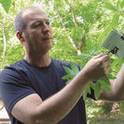Alliaria petiolata is a Eurasian biennial herb that is invasive in North America and for which phenotypic plasticity has been noted as a potentially important invasive trait. Using four European and four North American populations, we explored variation among populations in the response of a suite of antioxidant, antiherbivore, and morphological traits to the availability of water and nutrients and to jasmonic acid treatment. Multivariate analyses revealed substantial variation among populations in mean levels of these traits and in the response of this suite of traits to environmental variation, especially water availability. Univariate analyses revealed variation in plasticity among populations in the expression of all of the traits measured to at least one of these environmental factors, with the exception of leaf length. There was no evidence for continentally distinct plasticity patterns, but there was ample evidence for variation in phenotypic plasticity among the populations within continents. This implies that A. petiolata has the potential to evolve distinct phenotypic plasticity patterns within populations but that invasive populations are no more plastic than native populations.
Available at: http://works.bepress.com/don-cipollini/124/
